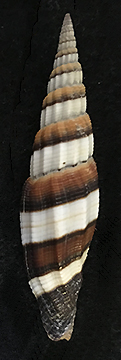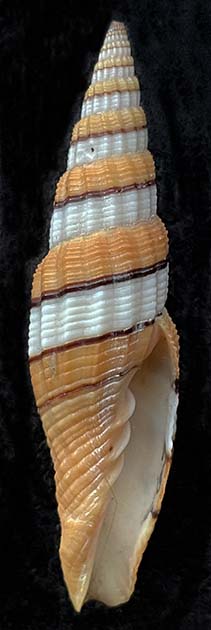Many year ago, I purchased two gastropod shells from the a shell store [now now closed] known as the “Tidepool Gallery” in Malibu, southern California. These shells, which have vivid color bands, are shown below. One has brown, black, and white spiral bands. The other shell has orange, white, and a few black spiral bands. It wasn't until until recently that I carefully studied these shells and decided to write a blog post about them. I immediately had problems in trying to identify them. I knew that they belonged to family Costellariidae and to genus Vexillum, but I was stumped when it came to identifying them as to species. Their colors are different than published images of this species, but colors in shells can be highly variable. Their morphology however is nearly the same, so I suspected that they belong to the same species. Consulting WoRMS (2023) confirmed my identification that both color variants are the same species; namely, Vexillum colosopulus (Jean Cate, 1961).
This gastropod belongs to family Costellariidae (= the ribbed miters). There are many species of this genus, and its high-spired multi-colored shells can show considerable variation in their color, with white, gray, orange, dark brown, and black spiral stripes. Cate’s species lives in tropical shallow-marine waters of the Western Pacific Ocean and Indian Ocean. This gastropod is predatory and, like other costellariids, it secretes toxins to immobilize and kill its prey.
Two views: apertural and abapertural, height 6.55 cm, width 1.5. cm) of Vexillum colosopulus (J.M. Cate, 1961), from Balbac, in the Philippines.
Two views: apertural and abapertural, height 5 cm, width 1.3 cm, of a different-colored variety of Vexillum colosopulus (J.M. Cate. 1961), West Pacific.
Cited References
Cate, Jean M. 1961. A discussion of Vexillum regina (Sowerby, 1825) and related species, with description of a new subspecies. The Veliger 4(9):76–85. [pdf available for free at biodiversitylibrary.org]
WoRMS, 2023. http://marinespecies.org




No comments:
Post a Comment